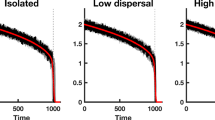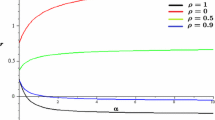Abstract
This paper considers several single species growth models featuring a carrying capacity, which are subject to random disturbances that lead to instantaneous population reduction at the disturbance times. This is motivated in part by growing concerns about the impacts of climate change. Our main goal is to understand whether or not the species can persist in the long run. We consider the discrete-time stochastic process obtained by sampling the system immediately after the disturbances, and find various thresholds for several modes of convergence of this discrete process, including thresholds for the absence or existence of a positively supported invariant distribution. These thresholds are given explicitly in terms of the intensity and frequency of the disturbances on the one hand, and the population’s growth characteristics on the other. We also perform a similar threshold analysis for the original continuous-time stochastic process, and obtain a formula that allows us to express the invariant distribution for this continuous-time process in terms of the invariant distribution of the discrete-time process, and vice versa. Examples illustrate that these distributions can differ, and this sends a cautionary message to practitioners who wish to parameterize these and related models using field data. Our analysis relies heavily on a particular feature shared by all the deterministic growth models considered here, namely that their solutions exhibit an exponentially weighted averaging property between a function of the initial condition, and the same function applied to the carrying capacity. This property is due to the fact that these systems can be transformed into affine systems.





Similar content being viewed by others
References
Bhattacharya RN, Majumdar M (2007) Random dynamical systems. Cambridge University Press, Cambridge
Bhattacharya RN, Waymire EC (1990) Stochastic processes with applications. Wiley, New York (reprinted in SIAM classics in applied mathematics series, (2009), vol 61)
Brandt A (1986) The stochastic equation \(Y_{n+1} = A_n \, Y_n + B_n\) with stationary coefficients. Adv Appl Probab 18(1):211–220. http://www.jstor.org/stable/1427243. Accessed 13 Feb 2018
Costa OLV (1990) Stationary distributions for piecewise-deterministic Markov processes. J Appl Probab 27(1):60–73. http://www.jstor.org/stable/3214595. Accessed 13 Feb 2018
Davis MHA (1984) Piecewise-deterministic Markov processes: a general class of non-diffusion stochastic models. J R Stat Soc Ser B (Methodol) 46(3):353–388. https://www.jstor.org/stable/2345677. Accessed 13 Feb 2018
Diaconis P, Freedman D (1999) Iterated random functions. SIAM Rev 41(1):45–76
Gilpin ME, Ayala FJ (1973) Global models of growth and competition. In: Proceedings of the national academy of sciences USA, Part I, vol 70, no 12, pp 3590–3593
Gompertz B (1825) On the nature of the function expressive of the law of human mortality, and on a new mode of determining the value of life contingencies. Philos Trans R Soc Lond 115:513–585
Hanson FB, Tuckwell HC (1978) Persistence times of populations with large random fluctuations. Theor Popul Biol 14:46–61
Hanson FB, Tuckwell HC (1981) Logistic growth with random density independent disasters. Theor Popul Biol 19:1–18
Hanson FB, Tuckwell HC (1997) Population growth with randomly distributed jumps. J Math Biol 36:169–187
Kingsland S (1982) The refractory model: the logistic curve and the history of population ecology. Q Rev Biol 57(1):29–52
Lande R (1993) Risks of population extinction from demographic and environmental stochasticity and random catastrophes. Am Nat 142(6):911–927. http://www.jstor.org/stable/2462690. Accessed 13 Feb 2018
Lande R, Engen S, Saether B-E (2003) Stochastic population dynamics in ecology and conservation. Oxford University Press, Oxford
Löpker A, Palmowski Z (2013) On time reversal of piecewise deterministic Markov processes. Electron. J. Probab. 18(13):1–29
Lotka AJ (1925) Elements of physical biology. Williams and Wilkins, Baltimore, pp 64–76
McMullen LE (2012) Ecological responses to riverine floods and flow alteration, Ph.D. thesis
McMullen LE, De Leenheer P, Tonkin JD, Lytle DA (2017) High mortality and enhanced recovery: modelling the countervailing effects of disturbance on population dynamics. Ecol Lett 20:1566–1575
Richards FJ (1959) A flexible growth function for empirical use. J Exp Bot 10:290–300
Schreiber SJ (2012) Persistence for stochastic difference equations: a mini-review. J Differ Equ Appl 18(8):1381–1403
Verhulst P-F (1838) Notice sur la loi que la population poursuit dans son accroissement. Corresp Math Phys 10:113–121
Acknowledgements
We would like to thank the Associate Editor and one Reviewer for making suggestions that have significantly improved an earlier draft of this paper. Funding was provided by National Science Foundation (Grant Nos. DMS-1411853, DMS-1408947).
Author information
Authors and Affiliations
Corresponding author
Appendix A: Proof of Theorem 3.1
Appendix A: Proof of Theorem 3.1
The continuous time evolution can be expressed in terms of the semigroup of linear contraction operators defined by
via its infinitesimal generator given by
To derive this simply observe that up to o(t) error as \(t\downarrow 0\), either one or no disturbance will occur in the time interval [0, t). Thus
The first term is, by the product differentiation rule,
The second term is \(\lambda Ef(\mathcal{D}_1 x)\) in the limit as \(t\downarrow 0\).
If \(\mu \) is an invariant probability distribution for this continuous time evolution then one has essentially from the Fokker–Planck equation \(L^*\mu = {d\over dt}\mu = 0\) for the adjoint operator, e.g., see Bhattacharya and Waymire (1990). In particular, for f belonging to the domain of L as an (unbounded) operator on \(L^2(\mu )\),
In the case of the discrete time evolution, the one-step transition operator is defined by
The condition for \(\pi \) to be an invariant probability distribution for the discrete time evolution is that for integrable functions f,
In particular, it suffices to consider indicator functions \(f = 1_C, C\subset (0,\infty ),\) in which case one has
These are the essential calculations required for the proof.
Let’s begin with part (i). First note from the definition of \(\mu \) that
Now, in view of the above calculation of L, one has
After an integration by parts this yields
Thus, using this and the invariance of \(\pi \) for the discrete process, one has
This proves part (i).
To prove part (ii), first apply L to the function \(x\rightarrow P(\mathcal{D}_1 g(T,x)\in C)\). First note from the composition property and an indicated change of variable,
In particular the first term of \(LP(\mathcal{D}_1 g(T,x)\in C)\) is
Adding this to the second term yields,
Integrating with respect to the continuous time invariant distribution \(\mu \) yields
or equivalently,
But since by definition \(\pi (dy) = \int _0^\infty P(\mathcal{D}_1 x\in dy)\mu (dx)\), this is precisely the condition
i.e., that \(\pi \) is an invariant probability for the discrete time distribution. \(\square \)
Rights and permissions
About this article
Cite this article
Peckham, S.D., Waymire, E.C. & De Leenheer, P. Critical thresholds for eventual extinction in randomly disturbed population growth models. J. Math. Biol. 77, 495–525 (2018). https://doi.org/10.1007/s00285-018-1217-y
Received:
Revised:
Published:
Issue Date:
DOI: https://doi.org/10.1007/s00285-018-1217-y




